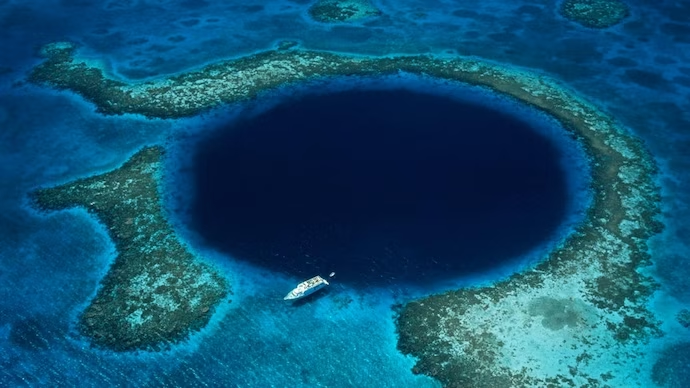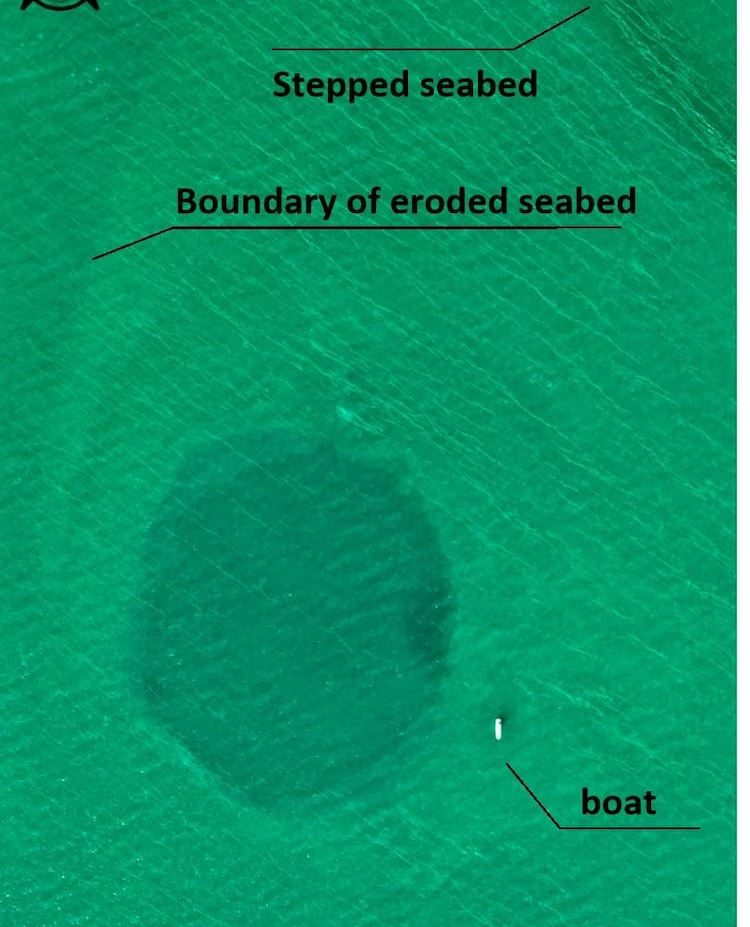Description

Copyright infringement not intended
Picture Courtesy: https://www.indiatoday.in/science/story/mysterious-900-foot-deep-blue-hole-discovered-in-mexico-2364463-2023-04-25
Context: The discovery of the massive sinkhole off the coast of the Yucatan Peninsula in Mexico, known as Taam Ja’ or "deep water" in Mayan, has captured the interest of scientists due to its mysterious origin and unique environment.
Location and Size
- Taam Ja’ is located in Chetumal Bay near the Yucatan Peninsula and covers an area of 13,660 square meters.
- It has a depth of approximately 900 feet, making it the second-deepest blue hole known on the planet.

Geomorphology
- The blue hole has a nearly circular shape at the surface and features steep sides that form a large conic structure.
- It is covered by biofilms, sediments, limestone, and gypsum ledges, which contribute to its unique appearance and ecosystem.
Scientific Exploration
- Researchers conducted extensive studies of Taam Ja’ using echo-sounding, thermohaline profiling, chemical analysis of water samples, and scuba diving.
- These efforts provided the first detailed documentation of this geomorphological feature and its environmental characteristics.
Environmental Significance
- Blue holes are known to contain unique environments and may offer insights into the evolution of life in marine ecosystems over millennia.
- Bacteria found at similar depths in other blue holes, such as those in the Caribbean, hint at the potential for unique microbial communities and evolutionary processes in these environments.
Physicochemical Variations
- Significant variations in salinity and temperature were observed within Taam Ja’, with surface salinity reflecting estuarine conditions and deeper layers indicating seawater influence.
- Monitoring of these physicochemical parameters over time will help scientists understand biogeochemical processes and water exchange dynamics with the surrounding estuary.
Comparison to Other Blue Holes
- While Taam Ja’ is one of the deepest blue holes discovered, the deepest known blue hole on the planet is located in the South China Sea, reaching a depth of 987 feet.
- Each blue hole has unique characteristics influenced by its geological context and environmental factors.

About Blue holes
- Blue holes are large marine caverns or sinkholes that have developed in carbonate bedrock (such as limestone or coral reefs).
- They typically contain tidally influenced water of fresh, marine, or mixed chemistry and extend below sea level for most of their depth.
- The formation of blue holes occurred during past ice ages when sea levels were lower, exposing these formations to erosion from rain and chemical weathering.
Characteristics
- Blue holes are roughly circular with steep walls, creating a contrast between the dark blue, deep waters and lighter blue shallows around them.
- Water circulation within blue holes is poor, leading to anoxic (oxygen-depleted) conditions at certain depths, which can support large numbers of bacteria.
Diversity and Life
- Blue holes harbour diverse microbial communities adapted to extreme conditions, including sulfur-based bacteria that thrive in anoxic environments.
- Fossils found in blue holes provide insights into past life forms, including crocodiles, tortoises, birds, and ancient native peoples.
- Sedimentation within blue holes preserves fossils and climate records, allowing scientists to study past environments.
Exploration and Expeditions
- Exploring blue holes requires specialized equipment and expertise due to the depth and overhead penetration involved.
- Scientific expeditions have yielded valuable data, such as 3D maps of blue-hole interiors and studies on microbial life in extreme environments.
- Blue holes are among the most dangerous diving sites due to factors like nitrogen narcosis, reduced visibility, and encounters with marine life like sharks.
Preservation and Research
- Blue holes preserve fossils and sediment records effectively due to anoxic conditions that inhibit decay.
- Research on blue holes contributes to understanding microbial life, biogeochemical processes, and past environmental changes.
|
Anoxic conditions refer to environments where oxygen levels are extremely low or absent. In the context of blue holes, which are deep underwater sinkholes or caverns, anoxic conditions can occur due to limited water circulation and the decomposition of organic matter without sufficient oxygen supply.
|
Conclusion
- Blue holes represent unique ecosystems with geological, biological, and environmental significance. They continue to be important subjects of scientific research and exploration, providing valuable insights into Earth's history and the limits of life in extreme aquatic environments
Source:
India Today
Wikipedia
|
PRACTICE QUESTION
Q. What is the primary reason why the water in a Blue Hole appears blue?
A) An abundance of blue algae living in the water.
B) Reflection of the blue sky.
C) The depth of the water scatters red light wavelengths.
D) The presence of unique minerals that tint the water.
Answer: C
|

















